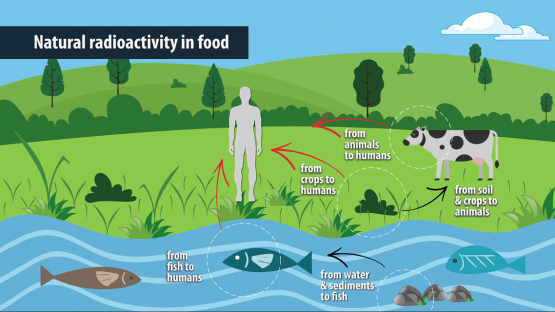All foods contain natural radionuclides, which are transferred from the soil to the crops on land and from water to fish in rivers, lakes and the sea. Levels of natural radionuclides in food and drinking water are generally very low and safe for human consumption. However, they can vary considerably depending on local geology, climate and agricultural practices.
The IAEA and international experts are therefore developing guidance to measure and determine acceptable levels of natural radioactivity in food, with the ultimate goal to improve food safety. Drinking water will be addressed later.
“We receive a small radiation dose from our diet every day. From a public health viewpoint it is insignificant in most cases, but it is still important to improve our knowledge of factors that impact doses received by consumers,” said Tony Colgan, Head of the IAEA’s Radiation Protection Unit.
At a meeting in Vienna on the topic last month, experts noted that norms and guidance have so far focused on levels of man-made radiation, while less attention has been paid to natural radiation. However, as Lieve Sweeck from the Belgian nuclear research centre SCK•CEN noted, assessing the movement and accumulation of natural radionuclides in the environment and in the food chain is important because the largest part of most people’s radiation dose comes from natural sources.
The World Health Organization has developed a framework, including guidance levels, for the management of both naturally-occurring and man-made radionuclides in drinking water[1]. The Joint FAO/WHO Codex Alimentarius Commission has also published Guideline Levels applicable to radionuclides contained in foods for human consumption and traded internationally, which have been contaminated following a nuclear or radiological emergency[2].
The IAEA will now seek to develop principles for harmonized guidance on natural radioactivity in food in non-emergency situations, trying to integrate the guidance with that already in place for man-made radionuclides. This includes a review of available information on the concentration of natural radionuclides in food, studying the circumstances in which elevated concentrations might occur and identifying radionuclides and foods of particular interest, including food for which little or no data are available.
Many countries conduct national monitoring programmes to determine the levels of radioactivity in food, and such programmes tend to focus on man-made radionuclides such as caesium, strontium and plutonium. Natural radionuclides, such as uranium, thorium, radium and polonium can be difficult and costly to measure in food and require facilities, equipment and human resources that many countries do not have.
At the meeting held on 30 October to 1 November 2017, experts from Belgium, Brazil, Iran and Russia presented work conducted to measure natural radionuclides in nationally-produced foods.
The meeting was also attended by representatives of FAO, the United National Scientific Committee on the Effects of Atomic Radiation (UNSCEAR) and WHO.
This activity comes in response to a request from Member States expressed at the IAEA General Conference Resolution GC(61)/RES/8. Additional meetings will be held this year and in 2018.
__________
[1] WORLD HEALTH ORGANIZATION, Guidelines for Drinking-water Quality — 4th Ed., WHO, Geneva(2011).
[2] JOINT FAO/WHO FOOD STANDARDS PROGRAMME, CODEX ALIMENTARIUS COMMISSION, Codex General Standard for Contaminants and Toxins in Food and Feed, Schedule 1 — Radionuclides, CODEX STAN 193-1995, CAC, Rome (2006).





